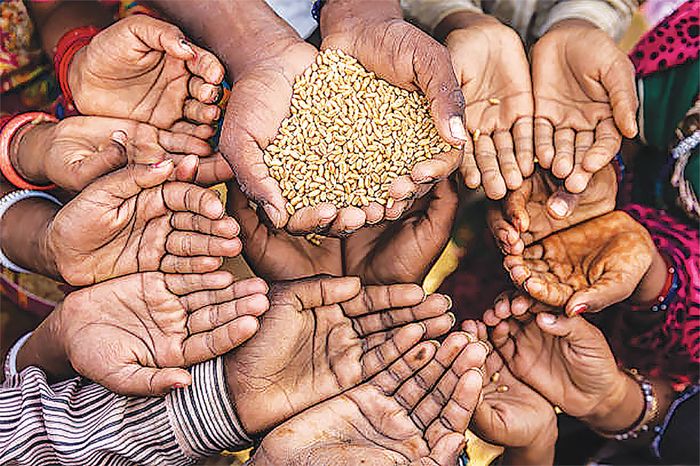India, the world’s fastest-growing big economy, is facing a serious challenge: skyrocketing food-price inflation.

The Big Idea
Food prices began to rise sharply in 2019 and have continued to grow in most years thereafter. Annual inflation surpassed 11% in July of this year, the highest level in a decade. A consequence of continuous high food-price inflation is that a segment of the population may struggle to consume food with enough nutritional content.
The bleak truth
- According to the FAO’s State of Food Security and Nutrition in the World report, an estimated 74% of India’s population, or about one billion people, cannot afford a decent diet by 2021.
- With a population of 1,400 million, this equates to around one billion Indians.
Factors contributing to India’s inability to curb food-price increases
- Supply-side Issues: Weather disturbances, infrastructure deficiencies, and inefficiencies in the supply chain all impede food production and distribution.
- Rising Input Costs: Rising fertiliser, pesticide, and labour costs raise production costs, resulting in higher food prices.
- Policies of the Government: Minimum support prices (MSPs) and export restrictions have an impact on market dynamics and prices.
- Macroeconomic Policy Ineffectiveness: Traditional macroeconomic strategies, which were relied on to manage inflation, have proven ineffectual in managing food-price inflation.
- The Reserve Bank of India (RBI), which is in charge of monetary policy in India, has persistently failed to manage inflation, with rates above the target for the past four years.
- Inadequacy of Inflation Targeting: The RBI’s technique of “inflation targeting,” which involves contraction of output during inflation spikes, is regarded as deceptive and inadequate for handling food inflation caused by supply-side concerns.
- Central banks, notably the RBI, are viewed as being incapable of properly tackling the problem of food-price inflation, especially within a realistic time frame.
A report on the trend of food prices in Mumbai from 2018 to 2023.
- Food Price Increases: The fundamental cause of food price inflation is an increase in the cost of food goods. From 2018 to 2023, the cost of preparing a traditional thaali lunch at home in Mumbai increased by 65%.
- Salary Growth Has Lagged: Although earnings for both manual and salaried workers have increased, with manual workers’ wages increasing by 38% and salaried workers’ wages increasing by 28% during the same period, these salary increases have not kept pace with the significant rise in food prices.
- Purchasing Power Erosion: Mumbai households have seen a significant decrease in purchasing power. Food prices have grown significantly, forcing people to devote a bigger amount of their income to food bills, leaving less for other critical requirements and discretionary spending.
- Nutritional Consequences: Food price inflation has had a negative nutritional impact, most notably an increase in the prevalence of anaemia, particularly among adult women in Mumbai. This increase in anaemia cases is mostly attributable to vitamin deficits induced by decreased access to nutritious meals due to rising food prices.
- The FAO’s Estimate’s Validity: According to FAO projections, more than half of India’s population may struggle to afford a healthful food. Even if the FAO overestimated the number by 100%, it would still leave a startling 500 million people in this category, outnumbering the populations of all countries except China.
The Green Revolution’s Importance
Food Self-Sufficiency:
- At the time of the Green Revolution, India was suffering from acute food shortages as a result of multiple droughts.
- The government’s supply-side solution, which included giving farmers with high-yielding seeds, low-interest finance, and guaranteed prices through procurement, was a huge success.
- Within a few years, India had achieved food self-sufficiency and was no longer reliant on food imports.
Economic and geopolitical significance:
- While certain mistakes were made during the Green Revolution, such as overuse of chemical fertilisers and an emphasis on cereals over pulses, the program’s success had far-reaching economic and geopolitical consequences.
- It enabled India to demonstrate its independence during the polarised Cold War era, which was a critical geopolitical factor.
Poverty Reduction:
- By improving agricultural output and farm incomes, the Green Revolution played a critical role in reducing poverty in India. Increased food production aided the poor by making food more available and affordable.
Lessons for the Future:
- While acknowledging past faults, the paper contends that the lessons of the Green Revolution can be applied to address the contemporary difficulties of food price inflation. The emphasis should be on correcting past mistakes and beginning a second agricultural revolution to reduce food production costs while assuring sustainability.
Initiatives proposed to reduce food price inflation and ensure everyone has access to healthful food.
- Increase Public Irrigation Investment: Address inefficiencies in public irrigation spending in order to expand irrigated acreage.
- Lift limits on land leasing in order to encourage productivity-boosting capital investments.
- Renew Agricultural Research: Renew India’s network of agricultural research institutes in order to harness innovation.
- Restore and strengthen agricultural extension services in order to propagate best practises.
- Concentrate on Protein Production: Create a programme to significantly enhance protein production in order to overcome India’s protein shortfall.
@the end
To address India’s food-price inflation situation, fast and coordinated action is required. Our previous accomplishments, such as the Green Revolution, demonstrate our ability to attack food security head on. Let us use this opportunity to create a second agricultural revolution, guaranteeing that every Indian has access to inexpensive, nutritious food and, once again, significantly decreasing poverty and malnutrition.
Source: https://www.thehindu.com/opinion/lead/ridding-india-of-food-insecurity/article67296175.ece
